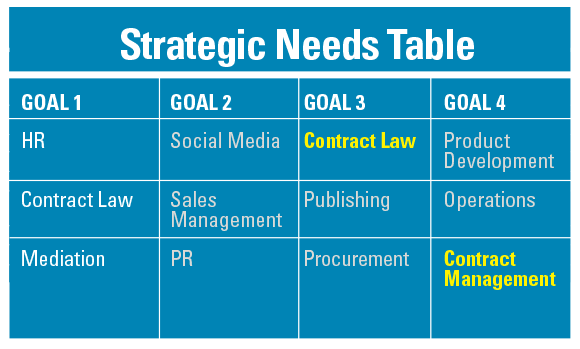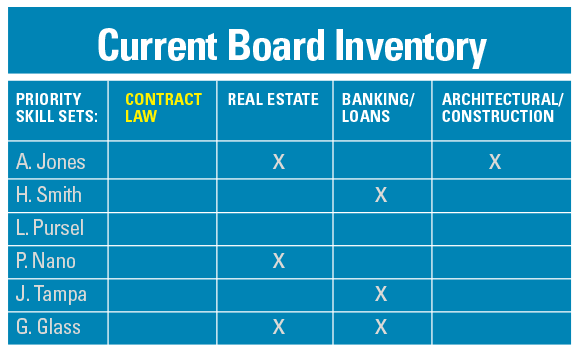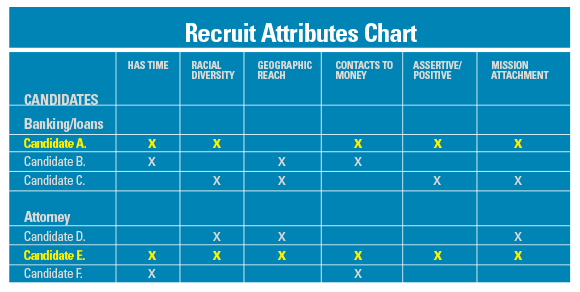Just as important as developing a deep individual relationship with each board member, it’s also important to understand what your team of individuals amounts to, and what qualities, skills, and connections it still needs to fulfill all your organization’s strategic goals – that is, to become a well-rounded, fully-functional super team capable of taking on any challenge. If constructed wisely, your board can work as your organization’s personal consulting team.
To figure out what kinds of individuals your team has, and what skills it still needs, you need a process for discerning assets and talent gaps on your board, in relation to your strategic goals. To do that, I advocate laying out your strategic goals and the skill sets necessary to achieve those goals, then determining which of those skill sets your board already has on hand. In our years training nonprofit EDs and boards, the Georgia Center for Nonprofits has developed a simple method for producing three handy reference charts that will align your organization’s goals with the skills available from the board. Properly aligned, that board can effectively drive initiatives to success, through advisement, the ability to connect or uncover resources, or literally by leading problem solving.
Moreover, when building a team, it is important to understand that you are also building a culture. Paying attention to the kind of board culture you want, and interviewing candidates for attributes as well as skills, will ensure that the board is in full alignment with the needs and values of the organization.
By implementing an intentional process for discerning strengths and gaps on the board, vetting candidates, and prioritizing them appropriately, you’ll find not only that your candidates are better suited to the work at hand, but that new members will begin their tenure with clearly defined roles.
Our foolproof methodology begins with a Strategic Needs Table.

Start by placing your organization’s strategic goals across the top row of a table. Think about the strategies you’ve decided on to reach those goals, and list the skill sets you’ll need to accomplish them beneath.
If your goal is to, say, increase the availability of quality affordable housing, one of your strategies might be to purchase and rehabilitate foreclosed properties, then rent them at an affordable rate. For that, you probably need a number of skill sets: real estate expertise to negotiate deals, banking expertise to assist with financing, an attorney to manage contracts, and a contractor for renovation and maintenance.
As you look across all your goals and strategies, you’re also looking for repeating skill sets. The need for an attorney, for instance, might arise across a number of goals. Therefore, having an attorney on your board might become a priority position to fill. This person could provide legal advisement, connections to other attorneys, or legal resources and guidance.
Before you can determine the types of board members you need to recruit, you’ve got to understand who on the board already understands the ins and outs of each strategy. To do that, you’ll need to construct a Current Board Inventory.

That means creating another table, this one listing the skill sets identified by your Strategic Needs Table across the top row and your current board members down the left-hand column. For each board member, put a check beneath the skill sets he or she possesses. If you don’t yet know your board members well enough to make an accurate inventory – and don’t assume you do – I advise creating a short survey that you can send through email or conduct over the phone. Be sure to ask about current and past employment; significant hobbies; major corporate, philanthropic, or donor relationships; professional association involvement; political positions held; and any other boards served on. You may be surprised!
With your board inventory finished, you should be able to see, at a glance, the strengths your board possesses and the gaps that need filling. That table should allow you to create a prioritized list of skills, talents, and connections you must seek in the next board members you recruit.
You also should take time to decide what you want in your next recruit, because you are creating a board culture as much as you’re seeking skills – and it won’t matter how many strategic needs a particular candidate fills if there’s no cultural fit. If he or she can’t connect with your organization, chances are the board member won’t stick around long enough make an impact.
To come up with a list of desired cultural attributes, think about the foundational values of your organization, the work style of your staff and programs, and the qualities you most appreciate in the board members you have. These might include an affinity for improvisation (or for long-term planning); an attitude of positivity and agreeableness (or skepticism and challenge); a certain geographic reach; a kind of diversity (racial, gender, socioeconomic, political); a particular community connection; or the ability to make a personal gift, or to get others to give. (At one nonprofit we work with, the key attribute is “nice.” That’s its code for assertive and positive, rather than contentious or argumentative.)
Once you’ve decided on these key attributes, you can create a Recruit Attributes Chart, much like the Current Board Inventory, accounting for these qualities in the candidates you interview. With that table, you can prioritize recruits who fulfill the same skill set by their “fit”: that is, how many cultural attributes one marketing expert fulfills, for example, compared to the other marketing experts you’re interviewing.

Of course, all of this is just preparation for your real work with the board: empowering your organization to fulfill all the promise of its mission. From here, it’s up to you to develop a purposeful, intentional plan that takes advantage of all the skills and strengths your board members possess.
Find more resources here or, for custom solutions, contact GCN’s Nonprofit Consulting Group.
Find top candidates, ready to serve, using The Board Finder.
Also see this list of leadership and professional organizations.